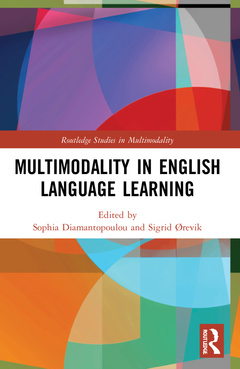Multimodality in English Language Learning Routledge Studies in Multimodality Series

This edited volume provides research-based knowledge on the use, production and assessment of multimodal texts in the teaching and learning of English as an Additional Language (EAL).
The book reflects growing interest in research on EAL, with increasing numbers of learners of English worldwide and the growing relevance of EAL to numerous education systems. The volume examines different aspects of English from a multimodal perspective, showcasing empirical research from across five continents and all three levels of education. Applying frameworks based on Multimodal Social Semiotics and Systemic Functional Linguistics, chapters focus on the use and affordances of multimodal texts in pedagogy, literature, culture, text production, assessment and curriculum development connected to EAL. Directing attention to the significance of modes beyond speech and writing in EAL, the volume provides a wide range of perspectives and experiences that can be applied more widely and inspire other practices in the global and diverse field of EAL teaching, learning and assessment.
This collection will be of interest to scholars in multimodality, language education, and teacher education.
List of Figures and Tables
Author biographies
Preface and Acknowledgements
Part I: Multimodality in the teaching and learning of English as an additional language: overarching perspectives
Chapter 1: Introduction. Multimodality in English language learning: the case of EAL
Chapter 2: A design-theoretic and multimodal approach to language teaching and learning
Chapter 3: Multimodal literacy in English as an additional language
Chapter 4: Games, literacy, literature: rules of grammar, rules of play
Chapter 5: Integrating multimodal and digital literacies in foreign language policy design: two examples from the Greek context
Part II: Making sense of multimodal texts in the English classroom: literary and cultural understandings of texts
Chapter 6: Constructions of English in a teacher training video: configuring global and local resources for the creation of an EAL community in Angola
Chapter 7: Introducing critical literacy and multimodal perspectives into film pedagogies for the EAL classroom
Chapter 8: Graphic novels in the EAL classroom: a pedagogical approach based on multimodal and intercultural understandings
Part III: Multimodal texts for English teaching and learning: language pedagogies and didactics
Chapter 9: Developing a Metafunctional Framework for Understanding the Design of Educational Apps
Chapter 10: The multimodal incorporation of tablet-based materials in the teaching of EAL: Comparison of pedagogic discourse in two primary classrooms in Thailand
Chapter 11: Theoretical perspectives on choice in multimodal text production and consequences for EAL task design
Part IV: Learners’ production of multimodal texts
Chapter 12: The mediatory role of whiteboards in the making of multimodal texts: implications of the transduction of speech to writing for the English classroom in tertiary settings
Chapter 13: ‘Reading’ literature through drawing: a multimodal pedagogic model for the EAL university classroom
Chapter 14: Multimodal text making through digital storytelling: EAL student teachers' reflections
Part V: Assessment of learners’ multimodal texts
Chapter 15: Designing for assessment as recognition of multimodal work in the EAL classroom
Chapter 16: The Common Framework of Reference for Intercultural Digital Literacies (CFRIDiL): learning as meaning making and assessment as recognition in English as an Additional Language contexts
Chapter 17: Assessing multimodal listening comprehension through online informative videos: the operationalisation of a new listening framework for ESP in higher education
Chapter 18: Developing an assessment framework for multimodal text production in the EAL classroom: The case of persuasive posters
Index
Sophia Diamantopoulou is a lecturer at the UCL Institute of Education and has previously worked as a teacher across a number of learning sites, including teaching EAL. She is a member of the Centre for Multimodal Research with interest in the fields of visual communication, social semiotics, museum education, and embodied learning.
Sigrid Ørevik, PhD, is an associate professor at the Department of Foreign Languages, University of Bergen, Norway, where she teaches and supervises student teachers of EAL. Her research focuses primarily on genre and multimodality in materials for teaching, learning, and assessment in the school subject of English.
Date de parution : 01-2024
15.2x22.9 cm
Date de parution : 12-2021
15.2x22.9 cm
Thème de Multimodality in English Language Learning :
Mots-clés :
Sigrid Ørevik; Sophia Diamantopoulou; multimodal texts; English as an additional language; English language education; English language learning; multimodality; Multimodality in English Language Learning; EAL; Multimodal literacy; digital literacies; EAL classroom; Educational Apps; EAL task design; Young Man; ESP in higher education; EAL Learner; EAL Teacher; EAL Class; EAL Student; Peer Assessment; Logico Semantic Relations; EAL Teaching; Critical Digital Literacy; Multimodal Social Semiotics; Multimodal Texts Produced; Systemic Functional Linguistics; Educational App; Conventional Assessment Practices; Digital Story; Main Communicative Mode; DST; Instructional Register; Graphic Novels; Active Learning Classroom; Multimodal Meaning Making



